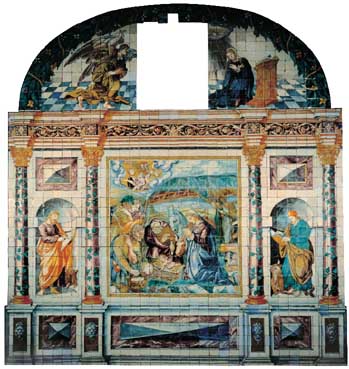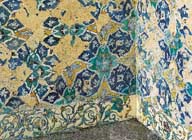|
|
|
|
|
|
|
|
|
|
|
|
|
|
 |
|
|
|
|
|
|
|
|
|
 |
|
|
|
|
|
|
|
|
The XVI Century
The Italian and Flemish
Influences
|
 he development of the ceramic art in Italy led to the use of the majolica technique to paint directly onto tiles. This made it possible to expand compositions to include a variety of figurative themes, historical stories and decorations. he development of the ceramic art in Italy led to the use of the majolica technique to paint directly onto tiles. This made it possible to expand compositions to include a variety of figurative themes, historical stories and decorations.
A number of Italian ceramists moved to the Flanders region, where they disseminated mannerist decorative motifs and the themes
of classical antiquity.
After Portuguese orders had been placed in Flanders, some Flemish ceramists moved to Lisbon, where they initiated the production of tiles in Portugal itself from the second half of the XVI century onwards.
Certain typical motifs with their origin in the Flemish mannerist style were in international use at the time and were adopted by Portuguese tile painters to create monumental compositions guided by the erudite skills of Masters of drawing and painting such as Francisco and Marçal de Matos.
|
|
|
|
 |
|
|
São Roque Church,
Francisco de Matos,
Lisbon, 1584.
photograph: Victor Franco (DDF-IPM)
|
|
|
|
|
|
 |
|
|
|
|
|
|
|
"Douro", Quinta da Bacalhoa,
The Tank Building, Azeitão,
. 1565.
hotograph: Nicolas Lemonnier
|
|
|
|
|
|
|
|
|
|
|
|
|
Panel depicting
Our Lady of Life,
Marçal de Matos,
c. 1580, MNA inv. 138.
photograph: José Pessoa (DDF-IPM)
|
|
|
|
|
 |
|
|
|
|
|
|
|
|
|
|
|
|
|
 |
|
|
|
|
|
Azulejo "Skirting-board",
Quinta da Bacalhoa,
The Tank Building, Azeitão,
c. 1565.
photograph: Nicolas Lemonnier
|
|
|
|
|
|
|
|
|
|
|
|
|
|
"Horseman", Antwerp, 1558,
rom the Vila Viçosa Duke?s Palace,
NA cat. 849.
hotograph: Francisco Matias (DDF-IPM)
|
|
|
|
|
|
|
|
© Instituto Camões, 2000
|
|
|
|